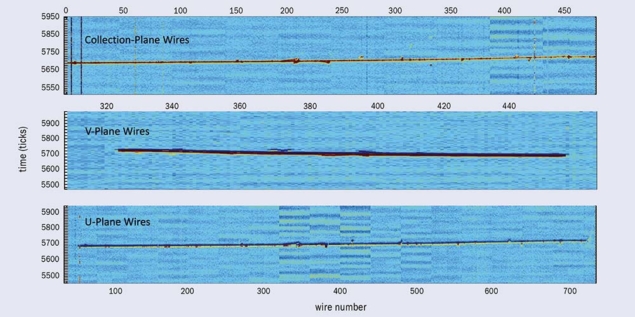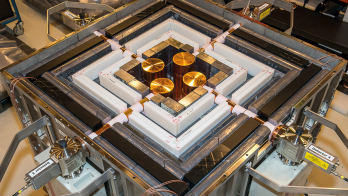
The world’s largest liquid-argon neutrino detector has recorded its first particle tracks in tests at CERN, marking an important step towards the international Deep Underground Neutrino Experiment (DUNE) under preparation in the US. The enormous ProtoDUNE detector, designed and built at CERN’s neutrino platform, is the first of two prototypes for what will be a much larger DUNE detector. Situated deep beneath the Sanford Underground Research Facility in South Dakota, four final DUNE detector modules (each 20 times larger than the current prototypes and containing a total of 70,000 tonnes of liquid argon) will record neutrinos sent from Fermilab’s Long Baseline Neutrino Facility some 1300 km away.
DUNE’s scientific targets include CP violation in the neutrino sector, studies of astrophysical neutrino sources, and searches for proton decay. When neutrinos enter the detector and strike argon nuclei they produce charged particles, which leave ionisation traces in the liquid from which a 3D event can be reconstructed. The first ProtoDUNE detector took two years to build and eight weeks to fill with 800 tonnes of liquid argon, which needs to be cooled to a temperature below –184 degrees. It adopts a single-phase architecture, which is an evolution from the 170 tonne MicroBooNE detector at Fermilab’s short-baseline neutrino facility. The second ProtoDUNE module adopts a different, dual-phase, scheme with a second detection chamber.
The construction and operation of ProtoDUNE will allow researchers to validate the membrane cryostat technology and associated cryogenics for the final detector, in addition to the networking and computing infrastructure. Now that the first tracks have been seen, from beam tests involving cosmic rays and charged-particle beams from CERN’s SPS, ProtoDUNE’s operation will be studied in greater depth. The charged-particle beam test enables critical calibration measurements necessary for precise calorimetry, and will also produce valuable data for optimising event-reconstruction algorithms. These and other measurements will help quantify and reduce systematic uncertainties for the DUNE far detector and significantly improve the physics reach of the experiment. “Seeing the first particle tracks is a major success for the entire DUNE collaboration,” said DUNE co-spokesperson Stefan Soldner-Rembold of the University of Manchester, UK.
More than 1000 scientists and engineers from 32 countries in five continents are working on the development, design and construction of the DUNE detectors. For CERN, it is the first time the European lab has invested in infrastructure and detector development for a particle-physics project in the US. “Only two years ago we completed the new building at CERN to house two large-scale prototype detectors that form the building blocks for DUNE,” said Marzio Nessi, head of the neutrino platform at CERN. “Now we have the first detector taking beautiful data, and the second detector, which uses a different approach to liquid-argon technology, will be online in a few months.”
In July, the US Department of Energy also formally approved PIP-II, an accelerator upgrade project at Fermilab required to deliver the high-power neutrino beam required for DUNE. First data at DUNE is expected in 2026. Meanwhile, in Japan, an experiment with similar scientific goals and also with scientific links to the CERN neutrino platform – Hyper-Kamiokande – has recently been granted seed funding for construction to begin in 2020 (CERN Courier October 2018 p11). Together with several other experiments such as KATRIN in Germany, physicists are closing in on the neutrino’s mysteries two decades after the discovery of neutrino oscillations (CERN Courier July/August 2018 p5).








